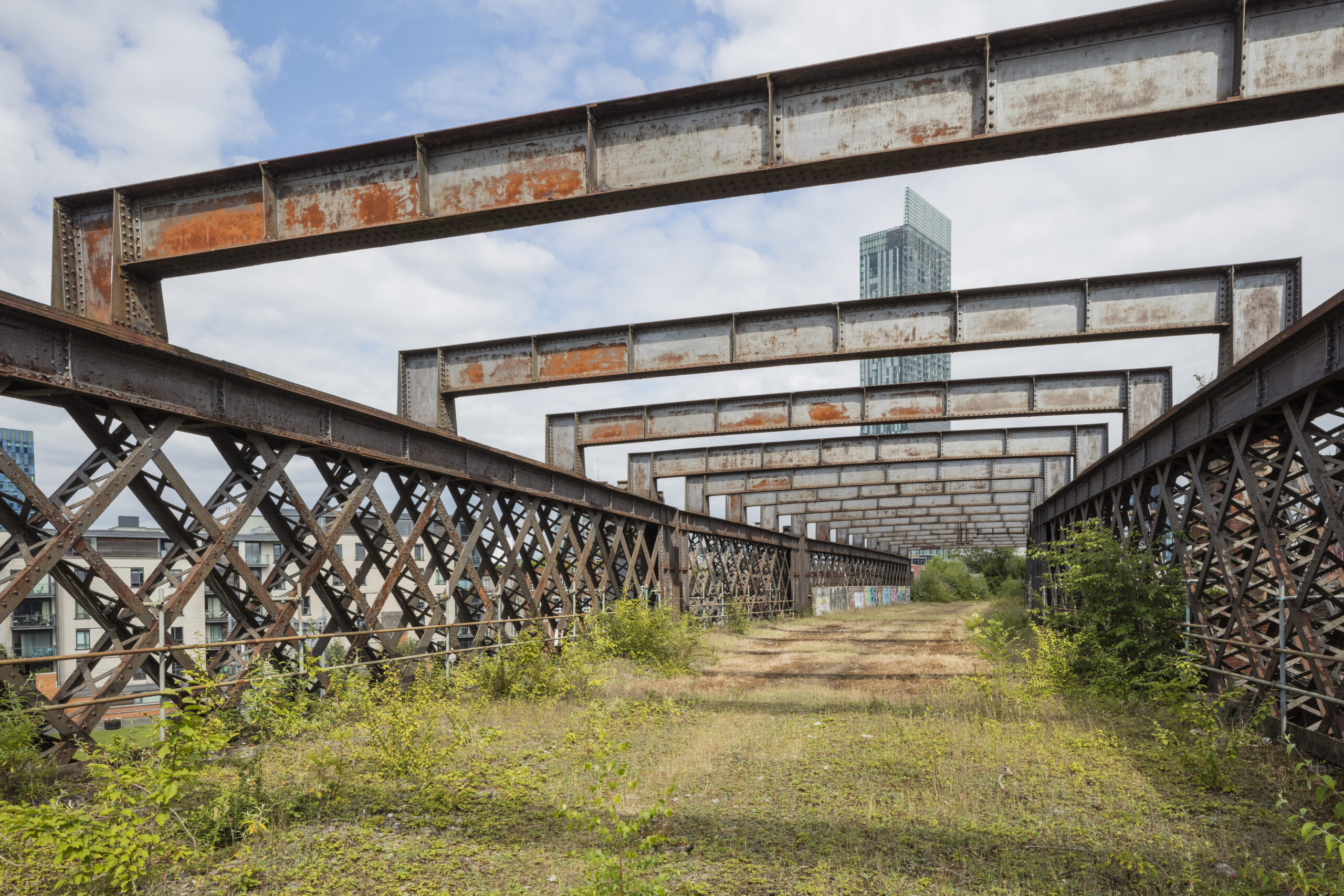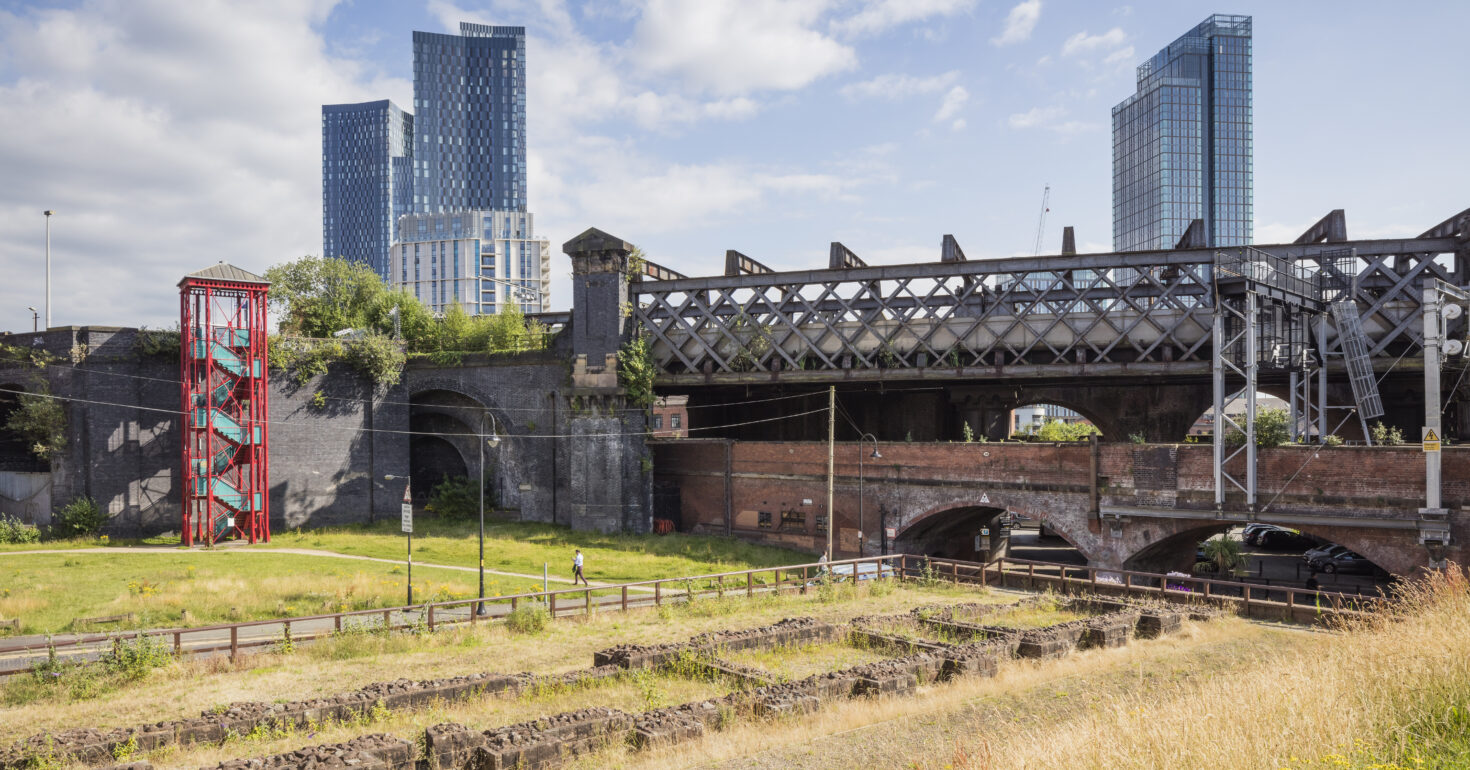With the final finishing touches now being made, the temporary Castlefield Viaduct urban park will open on Saturday 30th July for the next 12 months with green spaces stretching across the elevation.
During this time, visitors will have the opportunity to explore part of the structure and find out more about the viaduct’s heritage, the city’s long relationship with plants and trees and learn urban gardening tips. They’ll experience a variety of planting displays as they walk along the viaduct while enjoying the elevated setting above the historic cobbled streets. They’ll also see the park develop and evolve, responding to the different seasons.
The National Trust hopes to inspire and capture visitor and community opinions to help shape the longer-term future of the Grade II listed structure.
Hilary McGrady, Director-General of the National Trust says: “Today is incredibly exciting. The idea of transforming the viaduct has been around for a while, but it was always put in the ‘too hard to achieve box’ and set aside.


“For that long-held vision to finally come to life is therefore testament to the strong partnerships we have formed and the hard work of so many.
“What I love about this space is that it encapsulates so much of what the Trust’s work is about: opening up our shared heritage for everyone to enjoy, creating beautiful spaces and bringing people closer to nature. It’s about creating something new for the community, while also protecting an iconic piece of industrial history.
“We hope hundreds of people will visit and enjoy spending time in nature among the trees, shrubs and wildlife that is already starting to make this space its home. We’ll also be able to learn from this project and really start to understand more about what and how we can bring more green spaces and wildlife to thousands more people across the country in urban spaces.”
The plans for Castlefield Viaduct are part of the National Trust’s Urban Places work to increase access for all to nature, history and beauty in, around and near urban areas.

Head of Urban Places at the National Trust, Duncan Laird said: “This has been an intensely busy few months as we prepared to open the doors of the pilot project, and we are incredibly excited to finally be able to open this space for people to visit for the first time in over 50 years.
“As the trees and plants start to bed in and grow it will slowly begin to match the vision for this space. We will be keenly listening to visitor feedback that we will use to shape the ongoing evolution of the viaduct – we’re at the start of the journey; not the end!”
In addition to creating a place where people and nature meet, the new experience will also celebrate the industrial heritage of Castlefield which has been reflected through all elements of the design.
The design of the planters gives a subtle nod to the industrial architecture of the viaduct which was built in 1892 by Heenan and Froude, the engineers who worked on Blackpool Tower. The shape of the planters mirrors the curve of the viaduct and their width is the same as the railway tracks that once transported goods across the structure to the Great Northern Warehouse.
A section of the viaduct has also been left untouched to provide a sense of how nature has reclaimed the space since the site closed in the late 1960s.


Taking inspiration from what was already starting to grow naturally, much of the viaduct includes shrubs, ferns and grasses which frame the more colourful seasonal planting. Sections of the planting mimic the diamond shape of the viaduct’s criss-cross steelwork, achieved through diagonal blossom hedges and other plants.
Andy Jasper, National Head of Gardens & Parklands at the National Trust said: “Creating a garden on an industrial heritage structure such as this is new territory for us and we have created a test bed that represents how the park in the sky might be, if the people of Manchester want it.
“I cannot wait to see what people say and I am intrigued to see how the plant life will take in its new surroundings.
“With more than 3,000 individual plants planted in completely peat free growing media over the past couple of months, we’ve been literally trialling new planting techniques as we go – working with limited growing depths and thinking about how these plants will deal with the more challenging conditions of being 17 metres in the air.
“Due to weight limits on the structure, we have used a specially commissioned, extra light peat-free compost in all its planting on the viaduct. The planting will take a little while to establish and will develop through the seasons under the care of the Castlefield Gardener and volunteers.
“In addition to greening up a heritage structure, the planting reflects a true celebration of Manchester’s botanical heritage with the county flower, cotton grass, and fern species once collected by Manchester suffragist and botanist, Lydia Becker.”

Four plots on the viaduct have been handed over to partner organisations to create their own unique gardens[4] for visitors to enjoy. Called ‘partner plots’ these areas by Urban Wilderness, the Science and Industry Museum, City of Trees and Castlefield Forum.
Urban Wilderness have worked with Manchester based charity, 42nd Street, supporting young people who have suffered mental health challenges. Its ‘Garden of Possibilities’ features a geodesic dome and plants known for having positive effects on mental health including nettle, feverfew and lemon balm.
Laurel Gallagher, Co-Director of Urban Wilderness said: “The Castlefield Viaduct has so much to offer young people, especially those suffering with their mental health. We hope that young people across Manchester will have the opportunity to visit and feel like this space is for them.”
The Science and Industry Museum has filled its garden with plants that engage the senses and encourage visitors to take an active role exploring the local historical landscape. The planting takes inspiration from the museum’s globally significant site, formerly a bustling station at the terminus of the Liverpool and Manchester Railway, the world’s first steam-powered intercity railroad[5].

Alison Crook, Associate Curator at the Science and Industry Museum, said: “We are delighted to be a partner and reveal our plot which helps to tell the story of Manchester’s industrial past while looking forward towards a greener future. The planting echoes the museum’s own Planting Stories gardens, and will enable visitors to enjoy new multi-sensory ways of exploring Castlefield’s history.”
The theme of the City of Trees partner plot is ‘Trees – Past, Present and Future’. It showcases a variety of trees, shrubs and flowers that have been used throughout the Industrial Revolution, as well as displaying trees which are significant in Manchester today, helping the city respond to climate change. Plant species include box, gooseberry, damson and comfrey amongst many others.
Jessica Thompson, Director at City of Trees, says: “The Castlefield Viaduct is an amazing opportunity to be able to showcase the enduring value of trees to people and the environment through the ages.
“It’s ironic that timber from trees played such an important role in supporting the Industrial Revolution which has now led us down the path to climate change, however, trees are now a big part of the solution to making us less vulnerable to global heating – by locking up carbon, cooling our air and helping to intercept rainfall to reduce the risk of flooding. We hope that the sky park will inspire visitors to plant more trees and help protect the ones that we are already blessed with in Greater Manchester.”
Castlefield Forum have worked with landscape architects BDP to create their garden which mirrors the distinct features of Castlefield in both colour and scale including the viaduct, canal, Victorian warehouses and Roman fort which sits just beneath the viaduct[6].
Working with the local Saul Hay Gallery, it has also commissioned a unique artwork to form a central part of their plot.
Calum McGowan, Castlefield Forum Chair, says: “After many months in the planning, and even more years of dreaming, we are so looking forward to the opening of the Viaduct, to be able to share this wonderful space with others. We can’t wait to find out what they think. Our plot is a beautiful space, with flowers and plants that echo the legacy of this area, and a unique specially commissioned piece of public art. It will demonstrate how a group of local residents can come together and turn their vision and ideas into reality.”

Lead architects on the project, Twelve Architects & Masterplanners, have been working with the National Trust since 2021 to help the charity design the first phase of the project.
Matt Cartwright, Founding Director at Twelve Architects & Masterplanners says: “It is fantastic to see the pilot scheme about to open. It has been a pleasure to work with the team to start to reimagine the space. We hope it sparks a conversation for the public engagement which will help shape the ongoing plans for the transformation of this amazing structure as a unique green space for Manchester.”
Costing £1.8 million, the pilot has been made possible thanks to funding from Postcode Earth Trust supported by players of People’s Postcode Lottery, as well as public donations which covers two-thirds of the build costs.
Laura Chow, Head of Charities at People’s Postcode Lottery, said: “We’re delighted to see Castlefield Viaduct come alive to benefit the people of Manchester and that funding raised by our players is helping to make this happen.
“Over the past few years we’ve all seen how important access to green spaces and connecting with nature is to our wellbeing, so our hope is that by supporting this project we make this possible for even more people.”
The project has also been made possible thanks to working in collaboration with National Highways Historical Railways Estate Team, supported by Manchester City Council, Greater Manchester Combined Authority, Transport for Greater Manchester, the local community, businesses and supporters.
One hundred people a day will be able to visit the viaduct from next Saturday 30 July. Entry onto the structure will be free, but a booking system will be in place to help manage numbers. As part of the experience, visitors will be able to join guided walks. There are also plans to host various events to include community events, workshops and consultations. Please keep an eye on the Castlefield Viaduct for news about upcoming events.


